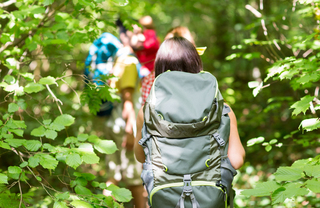Hiking in Yosemite

Nothing, they say, beats hiking in Yosemite. The experience of taking on any of the number of challenging (and not so challenging) trails draws in visitors from as far away as the apartments for rent in downtown SF, and sometimes even farther. It’s all for good reason — Yosemite National Park has more than 800 miles of trails for you tackle, and whether you’re a first-timer, experienced hiker, want to take the road well-traveled, or prefer something that feels more off the beaten path, there’s an option in the park for you:
“Yosemite National Park is home to some of the most scenic and spectacular hikes in the world. Over 3.5 million visitors travel from all corners of the world every year to marvel at the waterfalls and hike the famous trails of the 3rd oldest national park in the United States.”
What will you need to know to make the most of what’s available? That’s precisely what we’re going to tackle today. Yosemite is like a hiker’s paradise, and there’s whole lot of it to explore. We’re going to get you introduced to the ins-and-outs of hiking this magnificent stretch of land, and provide some options for a few spots in the park to hit if you’re ready to tackle those trails.
What Hiking in Yosemite is All About
Part of what makes hiking in Yosemite great is the amazing amount of diversity that comes with the terrain. According to AllTrails:
“The park's elevation ranges from 2000ft to 13,114ft (600m to 4,000m), stretching from Giant Sequoia groves housing 200ft trees over 2,000 years old, to breath-taking valleys carved by glaciers, and home to the highest waterfall in America, to alpine meadows filled with rivers, lakes, and wildflowers.”
That’s a lot of different scenery for you to enjoy, and enjoy you will, provided you take care to follow the rules and guidelines. First and foremost, remember the Park’s bullet points when it comes to taking on Yosemite’s trails:
Stay on trails: taking shortcuts causes trail erosion--and is both dangerous and illegal.
Carry (and drink) plenty of water: a leading cause of injuries on the trail is dehydration. Be sure to treat river, stream, lake, or spring water.
Pets and bicycles are only permitted on bike paths.
Horses and mules have the right of way on trails.
Pack out what you pack in.
Trails are not maintained nor are they regularly patrolled: travel carefully and at your own risk.
Smoking while traveling on trails is prohibited, though you may smoke while stopped except when fire restrictions are in effect. (Crush out and dispose of cigarette butts in a trash receptacle).
Beyond that, if you’re a first timer, you’re going to want to take a look at some beginner tips that will set you on the path to success. There are plenty of pitfalls that can ruin your fun if you aren’t careful, but if you stay aware and keep your wits about you, hiking the trails in Yosemite should be an outstanding experience.
The Best Trails in Yosemite
With that, let’s take a look at some of the best paths to tackle if you’re looking to enjoy the park. You can get a look at all the trailheads in the park by checking out the National Park Service’s Yosemite Wilderness Trailheads map, but we’re going to concentrate on the best day hikes in the park, courtesy of Lonely Planet:
Vernal & Nevada Falls
This is the trail to take if you can only do one adventure and it’s the spring. This pair of waterfalls is famed as Yosemite’s most gorgeous, and the rock formations you’ll see along the way make for some excellent photo opportunities. There are two ways to hit it, according to Lonely Planet: up the Mist Trail and down the John Muir Trail (in a clockwise direction) or vice versa.
Half Dome
Considered by many to be the “ultimate Yosemite Hike,” this is one that makes it onto nearly every list of amazing Yosemite hikes regardless of skill or other variables. The cliff views are worth it alone, and if you’re ready to see them for yourself, be sure to do so when it isn’t too crowded.
Tueeulala & Wapama Falls
More waterfalls, if you’re up for them! This pair is good for the springtime, and takes you around some much-lauded Yosemite landmarks, including Kolana Rock the nesting site for the park’s peregrine falcons. The word is that the falls can get so intense that “in springtime, after a good snowmelt, the falls can rage so mightily that the NPS occasionally has to close the trail itself as water rolls over the bridges.”
May Lake & Mount Hoffmann
Located in the center of the park, Mount Hoffman stands an impressive 10,850 feet tall, and will provide ample views for the whole of the park. It’s not a terribly long trip either, just about 40 minutes each way at normal speeds.
Cathedral Lakes
For lake lovers, Cathedral Lake should satisfy their thirst for views of pristine water. The lower lake is the more impressive of the two, but the upper one isn’t that far away if you want to take a peek at both.
Sentinel Dome
Want to check out a dome but don’t feel like contending with all the other visitors vying for Half Dome? Sentinel Dome will be your next option, then. The views are just as good, so don’t think of this as a poor man’s version at all.
Getting to Yosemite From San Francisco
Yosemite National Park is a about a 180 mile journey east of San Francisco. It’s a simple enough drive if you want to do it the “easy way.” Just hop on I-580 East until you hit CA-120, then use that road to take you straight to the park.
And There’s Plenty of Parking Near the Apartments for Rent in Downtown SF
If you’re a fan of hiking, you’ll love coming to the neighborhood near The Towers. San Francisco’s location near great spots like Muir Woods, the Marin Headlands, Land’s End, and The Presidio makes it ideal for hikers who want a beautiful view as the walk along their chosen trail. Plus, the thrill of being a resident at one of the premiere communities in the heart of the bustling Bay is something that adds a bit to almost any experience. Be sure to check it out, and see how great life in the Golden City can truly be.









